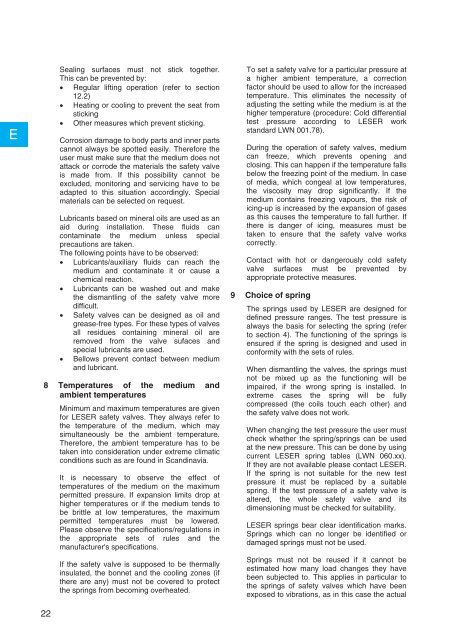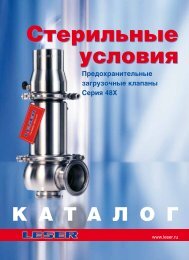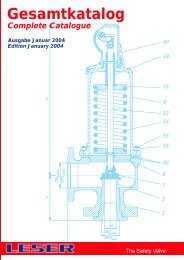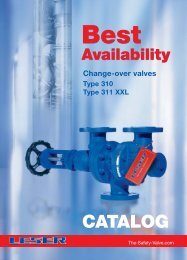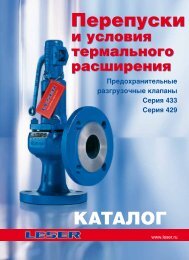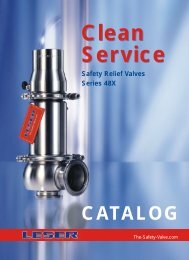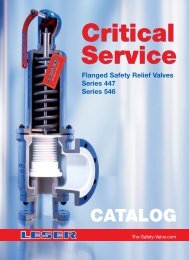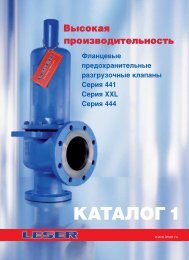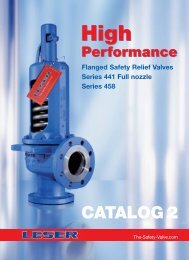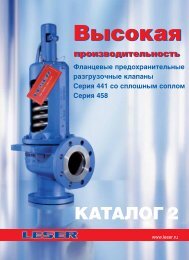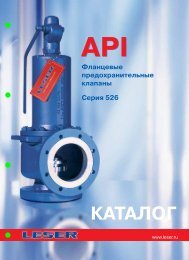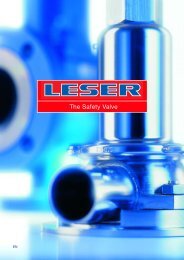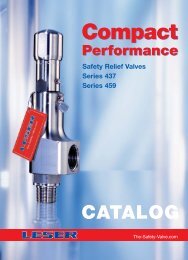operational manual - Leser.ru
operational manual - Leser.ru
operational manual - Leser.ru
You also want an ePaper? Increase the reach of your titles
YUMPU automatically turns print PDFs into web optimized ePapers that Google loves.
E<br />
Sealing surfaces must not stick together.<br />
This can be prevented by:<br />
• Regular lifting operation (refer to section<br />
12.2)<br />
• Heating or cooling to prevent the seat from<br />
sticking<br />
• Other measures which prevent sticking.<br />
Corrosion damage to body parts and inner parts<br />
cannot always be spotted easily. Therefore the<br />
user must make sure that the medium does not<br />
attack or corrode the materials the safety valve<br />
is made from. If this possibility cannot be<br />
excluded, monitoring and servicing have to be<br />
adapted to this situation accordingly. Special<br />
materials can be selected on request.<br />
Lubricants based on mineral oils are used as an<br />
aid during installation. These fluids can<br />
contaminate the medium unless special<br />
precautions are taken.<br />
The following points have to be observed:<br />
• Lubricants/auxiliary fluids can reach the<br />
medium and contaminate it or cause a<br />
chemical reaction.<br />
• Lubricants can be washed out and make<br />
the dismantling of the safety valve more<br />
difficult.<br />
• Safety valves can be designed as oil and<br />
grease-free types. For these types of valves<br />
all residues containing mineral oil are<br />
removed from the valve sufaces and<br />
special lubricants are used.<br />
• Bellows prevent contact between medium<br />
and lubricant.<br />
8 Temperatures of the medium and<br />
ambient temperatures<br />
Minimum and maximum temperatures are given<br />
for LESER safety valves. They always refer to<br />
the temperature of the medium, which may<br />
simultaneously be the ambient temperature.<br />
Therefore, the ambient temperature has to be<br />
taken into consideration under extreme climatic<br />
conditions such as are found in Scandinavia.<br />
22<br />
It is necessary to observe the effect of<br />
temperatures of the medium on the maximum<br />
permitted pressure. If expansion limits drop at<br />
higher temperatures or if the medium tends to<br />
be brittle at low temperatures, the maximum<br />
permitted temperatures must be lowered.<br />
Please observe the specifications/regulations in<br />
the appropriate sets of <strong>ru</strong>les and the<br />
manufacturer's specifications.<br />
If the safety valve is supposed to be thermally<br />
insulated, the bonnet and the cooling zones (if<br />
there are any) must not be covered to protect<br />
the springs from becoming overheated.<br />
To set a safety valve for a particular pressure at<br />
a higher ambient temperature, a correction<br />
factor should be used to allow for the increased<br />
temperature. This eliminates the necessity of<br />
adjusting the setting while the medium is at the<br />
higher temperature (procedure: Cold differential<br />
test pressure according to LESER work<br />
standard LWN 001.78).<br />
During the operation of safety valves, medium<br />
can freeze, which prevents opening and<br />
closing. This can happen if the temperature falls<br />
below the freezing point of the medium. In case<br />
of media, which congeal at low temperatures,<br />
the viscosity may drop significantly. If the<br />
medium contains freezing vapours, the risk of<br />
icing-up is increased by the expansion of gases<br />
as this causes the temperature to fall further. If<br />
there is danger of icing, measures must be<br />
taken to ensure that the safety valve works<br />
correctly.<br />
Contact with hot or dangerously cold safety<br />
valve surfaces must be prevented by<br />
appropriate protective measures.<br />
9 Choice of spring<br />
The springs used by LESER are designed for<br />
defined pressure ranges. The test pressure is<br />
always the basis for selecting the spring (refer<br />
to section 4). The functioning of the springs is<br />
ensured if the spring is designed and used in<br />
conformity with the sets of <strong>ru</strong>les.<br />
When dismantling the valves, the springs must<br />
not be mixed up as the functioning will be<br />
impaired, if the wrong spring is installed. In<br />
extreme cases the spring will be fully<br />
compressed (the coils touch each other) and<br />
the safety valve does not work.<br />
When changing the test pressure the user must<br />
check whether the spring/springs can be used<br />
at the new pressure. This can be done by using<br />
current LESER spring tables (LWN 060.xx).<br />
If they are not available please contact LESER.<br />
If the spring is not suitable for the new test<br />
pressure it must be replaced by a suitable<br />
spring. If the test pressure of a safety valve is<br />
altered, the whole safety valve and its<br />
dimensioning must be checked for suitability.<br />
LESER springs bear clear identification marks.<br />
Springs which can no longer be identified or<br />
damaged springs must not be used.<br />
Springs must not be reused if it cannot be<br />
estimated how many load changes they have<br />
been subjected to. This applies in particular to<br />
the springs of safety valves which have been<br />
exposed to vibrations, as in this case the actual<br />
22


